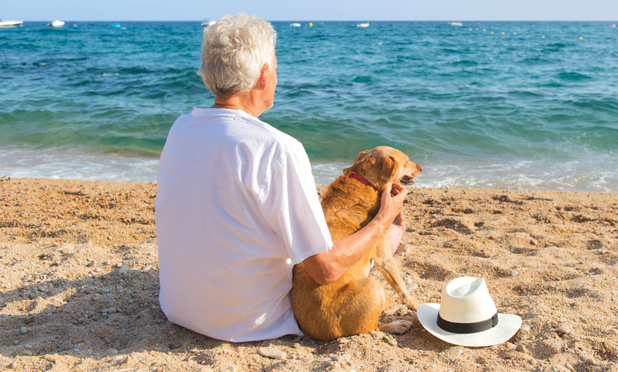The human population is getting older, and technology will play a key role in addressing the pressures this aging will place on healthcare systems. According to the 2015 United Nations’ World Population Ageing report [1], the number of people worldwide 60 and older will increase from one in eight in 2015 to one in six by 2030 and to one in five by 2050; in Europe and “Northern America” (mainly the United States and Canada), those 60 and older will make up 25% of the population by 2030, and in Asia and Latin America, the number is predicted to be 17%.
The report goes on to note that this upsurge in older people, and particularly those at very advanced ages, increases the “demand for care, services, and technologies to prevent and treat noncommunicable diseases and chronic conditions associated with old age.”
Workforce Multipliers
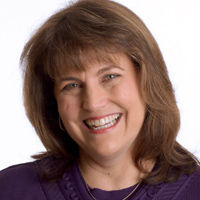
This aging of the population will only exacerbate the existing shortage of geriatricians, as well as elder-care institutions, and make technological involvement even more imperative, says Kari Olson (Figure 1, right), president of the Front Porch Center for Innovation and Wellbeing, a nonprofit organization working with university and company partners to harness technological solutions that support residents of Front Porch retirement communities, memory-care neighborhoods (facilities), skilled nursing care centers, and affordable housing communities in the United States [2].
In Olson’s view, “We’re going to have to find workforce multipliers, where we take the great people working in elder care and give them tools to become even more effective and reach more people. Technology has a clear role to play in this regard.” That means placing a greater emphasis on technologies such as interactive devices that can increase resident engagement to improve mood, fight depression, enhance socialization, and enable memory. Olson describes several currently in use.
A robotic, interactive baby harp seal called Paro [3]. Invented by Takanori Shibata, a researcher at Japan’s National Institute of Advanced Industrial Science and Technology, and available commercially for more than a decade, Paro has sensors to detect sound, touch, light, posture, and temperature and responds to patients with wiggles and squeals. “We brought it into our skilled-nursing settings and memory-care settings about two years ago,” Olson says, “and it has become an incredibly effective tool for our staff to use in helping calm agitated behaviors, draw out people who are noncommunicative, and assist with pain management” (Figure 2).
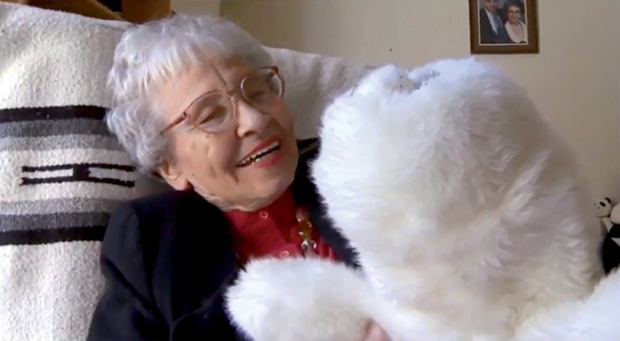
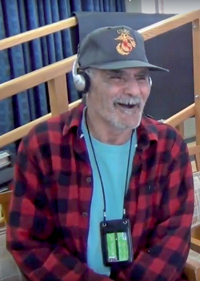
Personalized music playlists. Music & Memory [4] of Mineola, New York, trains professional and family caregivers in creating personalized playlists for elders who have Alzheimer’s disease or other cognitive and health challenges as a way to trigger memories (Figure 3, right). “This was an inexpensive way for us to see many of the same results we have seen with Paro, where people who weren’t engaging are now speaking and reminiscing, and there’s a definite impact on pain management and pain reduction,” Olson says. “It’s exciting from a lot of perspectives: low cost, high value, and high effectiveness.”
A scalable, simple-to-use touchscreen computer system called It’s Never Too Late (IN2L) [5]. Front Porch began a trial of the system in memory-care settings in June 2015, and the positive results were immediate. Residents began using personalized options on tablets (e.g., favorite websites, games, and e-mail or Skype access to connect with family), and resident groups used the system together on 70-inch touchscreen televisions to exercise, use a flight simulator, conduct an orchestra, and engage in a wide array of other activities (Figure 4). Olson explains, “It’s very common for memory-care residents to become reclusive, because there’s a risk of not remembering or of being unsuccessful in a conversation. But with IN2L, we’ll have a memory-care resident walk up to the 70-inch flat screen to do a jigsaw puzzle, and pretty soon she is helping other residents do the puzzle.” She adds, “We saw this overall brightening and livening up of everyone living and working in the memory-care neighborhood.” Front Porch has since deployed more than a dozen IN2L units, including several it added this past fall.
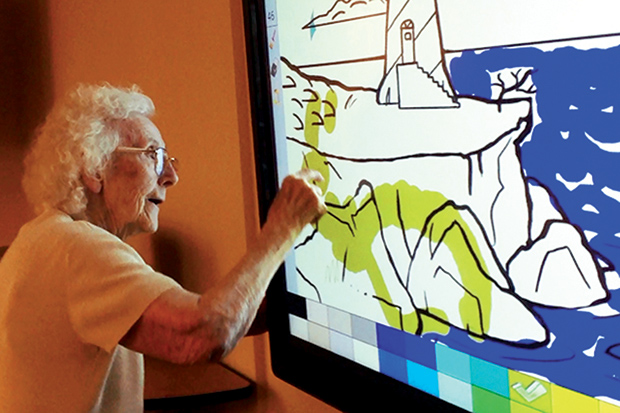
To develop similarly effective technologies for older populations, Olson stresses that innovators must discard assumptions and gain direct knowledge of the people they are trying to serve. “There are a lot of creative, motivated entrepreneurs out there coming up with great ideas that may be based on their personal experiences, but they’ve got to take the next step and vet it in a caregiving situation so they really are making the best solutions possible,” she advises.
In addition, innovators should collaborate from the beginning so that, rather than constantly reinventing, they are building on the work of their peers as well as leveraging networks. “In the aging space, one very active network for creating the intersection between developers and consumers is the Aging 2.0 network [6],” Olson says. This network “engages a range of innovative organizations that are bringing together entrepreneurs with senior-living businesses, as well as older adults themselves, to accelerate solutions, build business models, and identify pathways for products. It’s important that developers and people who are thinking about creating solutions tap into those accelerator networks early on.”
Home, Smart Home
Technologies for longer independent living also include in-home sensors that can identify potential health concerns and other devices that help encourage patients to care for themselves.
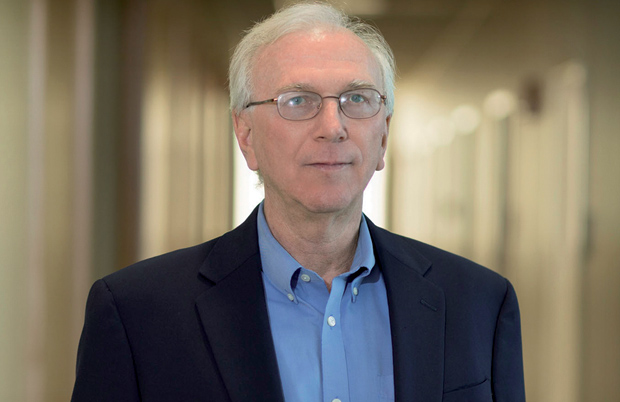
One innovator who has been working for some time on inhome sensors is John Stankovic, BP America Professor of Computer Science at the University of Virginia (Figure 5). His group’s Empath system [7], based on more than a decade of work and in use for several years now as a research tool, involves instrumenting the home to detect an individual’s alterations from normal behaviors. For instance, sleep sensors note how many times the person gets up at night, acoustic sensors detect voice inflection as a sign of mood, and additional sensors monitor multiple modalities, including light levels and changes in movement patterns that might suggest depression. Although Empath was developed strictly for research purposes, such passive sensor systems could one day be very useful for monitoring at-home elderly individuals, Stankovic says.
Smart wearables will provide even more monitoring capabilities than home instrumentation, notes Stankovic, who ran a smart-wearables panel during the IEEE Wireless Health 2016 meeting at the National Institutes of Health in Bethesda, Maryland, last October [8]. “Smart wearables, such as watches, bands, pendants, or the smart buttons my group is developing, have the potential to revolutionize medicine,” he remarks, “because they can be with the person always and they can pick up physiological parameters because they can be touching the skin.”
Besides monitoring environmental conditions and physiological parameters, including pulse and temperature, wearables also can be designed to provide reminders to patients to take certain healthy actions, such as drinking water or doing their exercises, Stankovic says.
The biggest issue he sees with these types of reminder systems is making them effective over the long term. “We find that patients will use technology for a while, and then that use drops off dramatically,” explains Stankovic. What health reminder systems need, he contends, is a blend of personalization and constant upgrades in functionality. “Everyone reacts to reminders and interventions differently, so the device has to have the ability to provide you with a reminder, identify when your response is dropping off, and then adapt to adjust the reminder until it finds something that works again.”
Take Your Medicine

Another type of device Stankovic believes could be particularly useful is one that monitors whether a patient is taking his or her medication at home. This is especially important for older patients who are on multiple medications that must be taken at different times throughout the day.
One new appliance for just that purpose is HERO, currently in development by HERO Health LLC of Brooklyn, New York [9]. About the size of a coffeemaker, it stores, sorts, dispenses, and tracks medications, vitamins, and other pills reliably and on time, according to Kurt Akdogan, who engineered the device and cofounded the company (Figures 6 and 7, right and below).
Other pill-dispensing devices have required users to presort their pills themselves, but HERO is designed so that users simply dump their pills in bulk into one of ten cartridges, he explains. “Our philosophy was to make this as easy as possible, so our electromechanical challenge was quite a big one. Eventually, we engineered a pickup system, we filed a number of patents around it, and got it to where we wanted with respect to complete reliability and accuracy.” Akdogan explains that the system is actually based in part on the gigantic pick-and-place robotics systems that large pharmaceutical factories use to count and scoop up individual pills at blurringly high speeds. Rather than going after speed, he says, his group focused on dispensing any size or geometry of pill correctly each and every time.
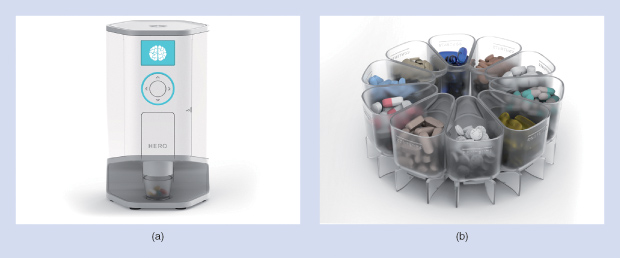
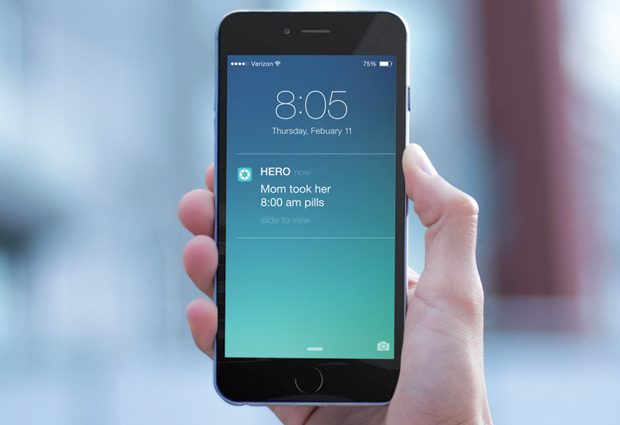
Beyond the dispensing role, Akdogan describes, HERO also provides a software ecosystem that alerts the individual when it’s time to take a dose, via automated text message, e-mail, telephone call, or other means. It also alerts designated caregivers when a dose is taken (Figure 8). If a dose is missed, a separate alert goes out via a tiered network of designated individuals until the dose has been taken. “If there’s no response and it’s a critical scenario, the system finally gets in touch with emergency services,” he adds.
The company had a limited commercial release of HERO last year and is planning a mass-production launch in 2017. It is now working on additional services on the provider side and partnering with a pharmaceutical company on the fulfillment side so patients automatically receive refills as their supplies run low.
Akdogan believes HERO has met with success so far because he and the company did what many innovators older individuals, the availability of regular house calls can mean the difference between living at home and having to move into a care facility. However, to make the most of house calls, medical systems require efficiency in serving a maximum number of patients in a minimal timeframe, providers want to give patients top-notch care with as little scheduling stress as possible, and patients want a consistent provider who gives excellent care and arrives on time.
A new software system, Intelligent Dynamic Scheduler for Healthcare [10], is in development to address all of these often-competing demands, according to Zachary Rubinstein, principal project scientist at the Robotics Institute at Carnegie Mellon University (Figure 9). He is working on the project with Celtic Healthcare and Allegheny Health Network Healthcare@Home in Pennsylvania.
The software system is designed to take into account the entire scheduling landscape. That begins with selecting a patient’s in-home provider based on a wide variety of parameters including optimal routes for the pool of providers; regulatory constraints, such as limits on Medicare reimbursements that might affect visits to a patient; medical requests from the doctor (e.g., visits twice a week but at least three days apart); and the patient’s scheduling preferences, Rubinstein says. In addition, the system monitors a provider’s progress as he or she proceeds from one home visit to the next and adjusts the schedule as necessary. If providers fall behind, the system automatically apprises the patients of delays and the anticipated time of arrival. An initial pilot of the system is slated to begin in 2017.
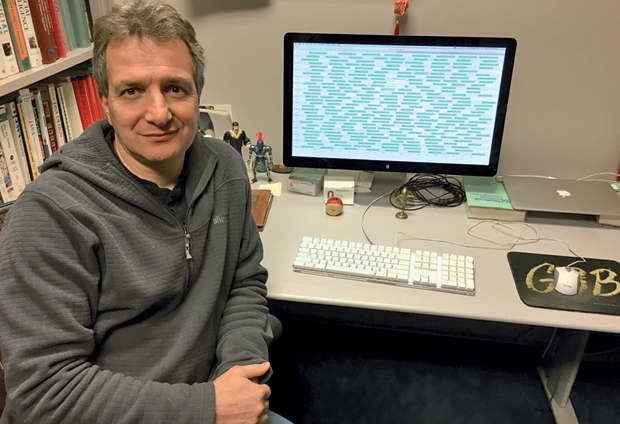
Rubinstein is looking forward to both positive and negative feedback from patients, providers, and health systems so he and his research group can ultimately create a scheduling system that works well for everyone. He thinks such a give and take between innovators and users is exactly the kind of thing all innovators should expect and pursue. “The biggest problem is bridging the gap between the technical solution and the adaptability to the population it serves,” he points out. “Sure, a lot of these problems are interesting from a research and technical point of view, but they’ll never see the light of day in terms of operations if they’re not better suited to the requirements of the people they’re serving.”
Doing It Right
The aging of the human population makes thoughtful technological solutions all the more important, especially at a time when healthcare costs are soaring and the ratio of staff to patients is decreasing, remarks Olson.
These same challenges exist in varying degrees throughout the world. Referring to the United States, Olson says, “The aging population has widespread ramifications for us as a nation, as an economy, as a community, and as citizens. We can’t possibly build enough community-based homes for everyone, so we need to support people in their own homes.” She adds, “With the pressing need come tremendous technological opportunities to be creative and to figure out how we can do even better and at the same time meet the needs of a growing number of people.”
To deliver excellent innovations in the elder-care arena, developers need to learn the audience, understand the healthcare system, and work together, Olson says. “We are in an era when caring people can make a huge impact in an area that needs impact, but I think it takes a village. As long as people can tap into the networks that help them understand the needs, the opportunities, and how to find solutions fast, they can leverage the learning of others already in this space and therefore have the greatest likelihood of success.”
References
- World population ageing. (2015). United Nations, New York. [Online].
- K. Olson, D. Park, J. Santos, J. Yoon, and C. Karapetian. Front Porch Center for Innovation and Wellbeing. [Online].
- Paro: Therapeutic Robot. [Online].
- Music & Memory. [Online].
- It’s never 2 late: Dignity through technology. [Online].
- Aging 2.0. [Online].
- R. F. Dickerson, E. I. Gorlin, and J. A. Stankovic. (2011, Oct.). Empath: A continuous remote emotional health monitoring system for depression. [Online].
- IEEE Wireless Health 2016: Agenda. [Online].
- HERO. [Online].
- Celtic Hospice and Home Health. (2016, July 18). The future is now: Intelligent delivery of in-home health, hospice & palliative care. [Online].



